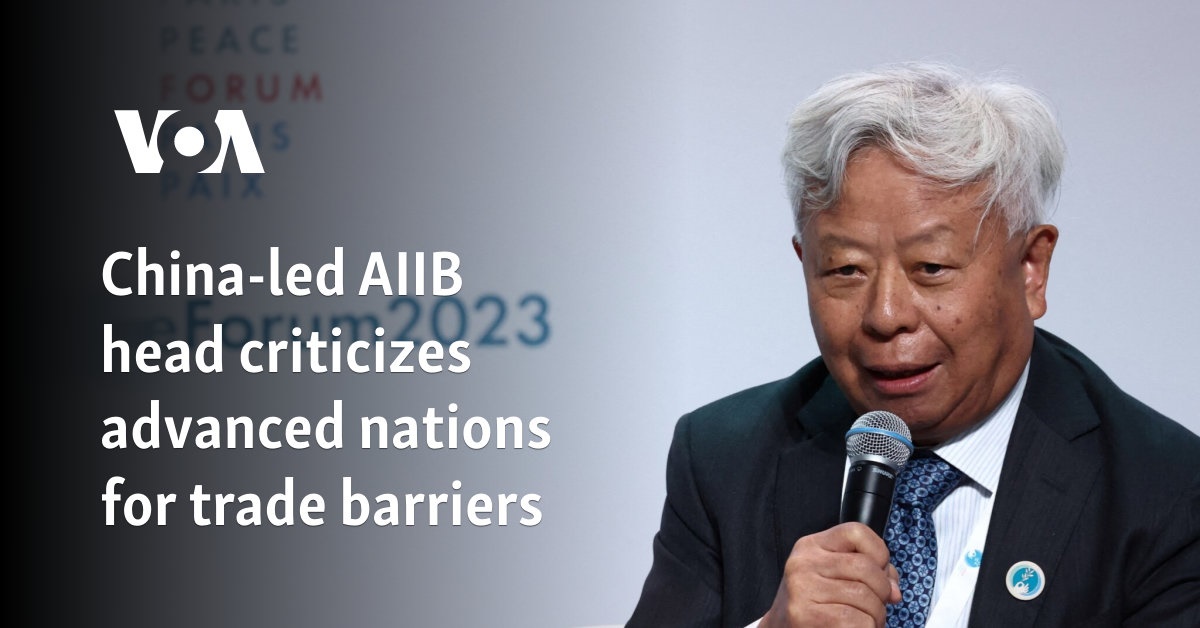China-led AIIB head criticizes advanced nations for trade barriers – VOA Asia

Asian Infrastructure Investment Bank President Criticizes Trade Barriers
Introduction

Washington —
The President of the Asian Infrastructure Investment Bank (AIIB), Jin Liqun, expressed his criticism towards advanced economies for implementing trade barriers, particularly for renewable energy goods. He argued that the global economy no longer experiences free trade due to these barriers.
Trade Barriers on Renewable Energy Goods
Last month, the United States imposed significant tariff increases on Chinese imports, including a 100% duty on electric vehicles. This move aimed to protect strategic domestic industries from China’s state-driven excess production capacity. The European Union and Canada have also announced new import tariffs on Chinese electric vehicles, matching the 100% duties imposed by the United States.
Increase in Trade Spats
Jin, the President of AIIB, highlighted that trade disputes between advanced and emerging economies have escalated due to the increased competitiveness of manufacturers in the latter. Emerging economies that enhance their trade capacity and become competitive may face accusations of over-capacity, regardless of the benefits they bring to their trade partners. Jin emphasized that this situation indicates a departure from free trade, as reliance on World Trade Organization (WTO) rules is no longer sufficient.
Barriers to Low Carbon and Renewable Energy Products
Jin expressed concern over the rising barriers to trade in low carbon and renewable energy products. He emphasized the importance of these green products in saving the planet. However, the barriers to their trade are increasing at an alarming rate.
AIIB as an Alternative to Western-led Multilateral Lenders
Established by President Xi Jinping in 2016, AIIB serves as a Chinese alternative to the World Bank and other Western-led multilateral lenders. Jin expressed his dismay over the trade disputes, highlighting the significant benefits that free trade has brought to numerous countries since the end of World War II.
China’s Stimulus Measures
Jin also discussed the stimulus measures implemented by the Chinese government. He noted that these measures differ from those deployed during the global financial crisis of 2008-2009. The current measures are more focused and aim to expand fiscal stimulus. China has been proactive in increasing spending and issuing special bonds to support local governments and businesses.
SDGs, Targets, and Indicators Analysis
1. SDGs Addressed or Connected to the Issues Highlighted in the Article
- SDG 8: Decent Work and Economic Growth
- SDG 9: Industry, Innovation, and Infrastructure
- SDG 12: Responsible Consumption and Production
- SDG 13: Climate Action
- SDG 17: Partnerships for the Goals
The article discusses trade barriers and the impact on renewable energy goods, which are connected to SDG 8 and SDG 9. SDG 8 focuses on promoting sustained, inclusive, and sustainable economic growth, full and productive employment, and decent work for all. SDG 9 aims to build resilient infrastructure, promote inclusive and sustainable industrialization, and foster innovation. The article also mentions the need for low carbon and renewable energy products to save the planet, which is related to SDG 12 (responsible consumption and production) and SDG 13 (climate action). Lastly, the article highlights the importance of international cooperation and partnerships, aligning with SDG 17.
2. Specific Targets Under the Identified SDGs
- SDG 8.2: Achieve higher levels of economic productivity through diversification, technological upgrading, and innovation.
- SDG 9.1: Develop quality, reliable, sustainable, and resilient infrastructure.
- SDG 12.2: Achieve sustainable management and efficient use of natural resources.
- SDG 13.2: Integrate climate change measures into national policies, strategies, and planning.
- SDG 17.16: Enhance the global partnership for sustainable development, complemented by multi-stakeholder partnerships.
Based on the article’s content, these targets are relevant as they address the need for economic productivity, sustainable infrastructure, responsible resource management, climate change integration, and global partnerships.
3. Indicators Mentioned or Implied in the Article
- Trade barriers on renewable energy goods
- Increased competitiveness of emerging economies
- Barriers to trade in low carbon and renewable energy products
The article mentions trade barriers on renewable energy goods, which can be an indicator of the challenges faced in achieving SDG 12.2 (sustainable management and efficient use of natural resources) and SDG 13.2 (integration of climate change measures). The increased competitiveness of emerging economies can be an indicator of progress towards SDG 8.2 (economic productivity through innovation). The barriers to trade in low carbon and renewable energy products can be an indicator of the challenges faced in achieving SDG 12.2 and SDG 13.2, as well as SDG 17.16 (enhancing global partnerships).
SDGs, Targets, and Indicators Table
| SDGs | Targets | Indicators |
|---|---|---|
| SDG 8: Decent Work and Economic Growth | 8.2: Achieve higher levels of economic productivity through diversification, technological upgrading, and innovation. | Increased competitiveness of emerging economies |
| SDG 9: Industry, Innovation, and Infrastructure | 9.1: Develop quality, reliable, sustainable, and resilient infrastructure. | Trade barriers on renewable energy goods |
| SDG 12: Responsible Consumption and Production | 12.2: Achieve sustainable management and efficient use of natural resources. | Trade barriers on renewable energy goods |
| SDG 13: Climate Action | 13.2: Integrate climate change measures into national policies, strategies, and planning. | Trade barriers on renewable energy goods |
| SDG 17: Partnerships for the Goals | 17.16: Enhance the global partnership for sustainable development, complemented by multi-stakeholder partnerships. | Barriers to trade in low carbon and renewable energy products |
Source: voanews.com








